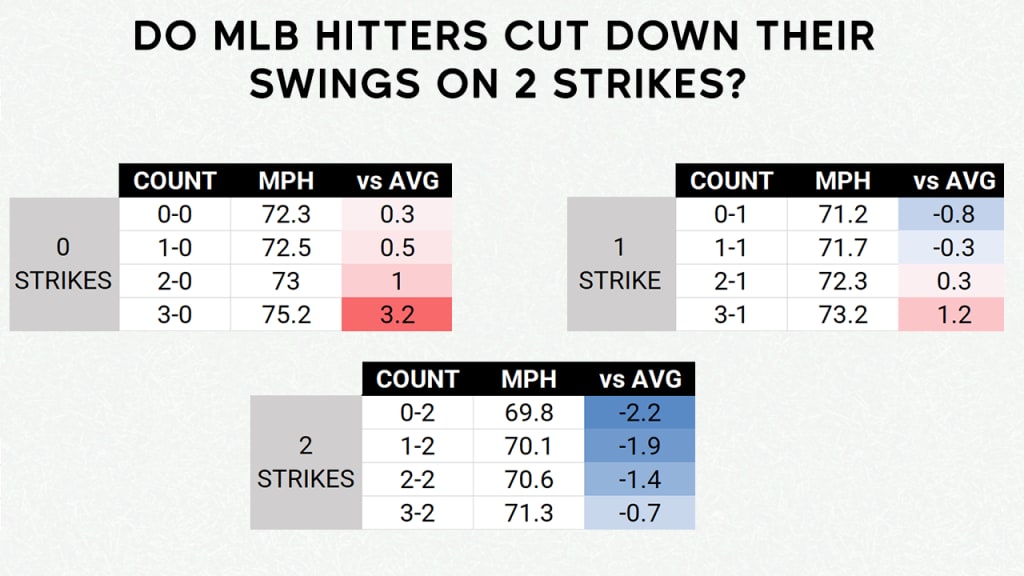Do hitters have a two-strike approach these days? To see the strikeout rate, which climbs and climbs each year, you’d say perhaps not; to hear old-timers tell it, you’d hear definitely not.
We can’t really tell you what batters were thinking in 1924 or 1974 or even 2014. But in 2024, we now have the first season of Statcast bat-tracking metrics up and running, and the answer is, it seems: yes. They do. Just look at how much the bat speed declines when the counts gets to something-and-two:
On two strikes, batters swing 1.6 mph slower than they do before two strikes. They cut their fast-swing rate – that’s swings of 75 mph or harder – down from 26% to 17%.
As you might expect, overall, count is a pretty strong determinant in terms of how fast a batter will swing. On 3-0, they're willing to really let it eat, swinging +3.2 MPH harder than the overall average. On 0-2, it's a mere 69.8 MPH, down 2.2 MPH from the average -- and, taking the extremes here, there's now a 5.7 MPH bat speed difference between 3-0 and 0-2. Which is, of course, massive.

(Is it just about the different types of pitches that might be seen on different counts? Perhaps, but swings against fast pitches [95 mph+] and slow pitches [85 mph and under] decline at an identical 1.6 mph between zero or one strike and two strikes, so it’s not clearly obvious here.)
Teams and players, of course, talk about this all the time.
- “They stuck with it, showed patience and did a nice job of two-strike hitting,” said Texas manager Bruce Bochy after his Rangers took out the Orioles in the playoffs last year.
- “[Cody] Bellinger made noticeable changes to make contact with two strikes,” an anonymous scout told The Athletic about the Cubs star's rebound season in 2023.
It would be difficult to hear these quotes, and approximately a billion others, and think there’s not a change in approach.
“If I take five or six bad swings in the cage,” Colorado infielder Ryan McMahon said to the Denver Post earlier this year, “I’ll yell at the [hitting] coaches, ‘Hey, two-strike approach.’ Then, I’ll go to it until I find my swing.”
McMahon, for what it’s worth, doesn't just say it. He lives it, displaying one of the larger two-strike drops in baseball, cutting his fast-swing rate in half. “Hey, two-strike approach,” indeed.
In fact, every single team in the Majors cuts their swing rate on two strikes. Twenty-nine of them cut it by between 1-2 mph. Then there’s the Rays, who drop their swings by a full 2.6 mph, and while there’s not exactly any particular correlation here between “drop in two-strike bat speed” and “overall hitting success,” is there anyone left who thinks that when the Rays stand out in something, that thing has happened by accident?

Now: Is it working? Maybe a little. Hitters who have gotten to a two-strike count are already in a bad situation, of course, but the swing-and-miss rate on two strikes (24.3%) is indeed slightly less than it is before two strikes (26%), which lends credence to the fact that they’re at least trying to make more contact.
Some, however, appear to be trying more than others. There are 234 hitters with at least 50 swings in both situations, and two-thirds of them drop their swing speed between 1-3 mph, which shows it’s a real concern. A few dozen more drop it negligibly, by a few fractions of a mph. A small handful of true heroes actually swing harder on two strikes, led by Washington’s Jesse Winker, who jumps from 68.9 mph to 69.7 mph.
But then there are those who are really, really trying. Among those with at least 50 swings in both situations (on two strikes and before two strikes), these hitters have dropped their bat speed by at least 3.5 mph in two-strike counts.
- -4.2 MPH José Caballero, TB
- -4.0 MPH Nolan Arenado, STL
- -3.8 MPH Harrison Bader, NYM
- -3.6 MPH Jeimer Candelario, CIN
- -3.5 MPH Jake McCarthy, AZ
Caballero, in particular, really seems to be committing to this, going from 71.7 mph before two strikes to 67.5 mph on two strikes, and his swing-and-miss rate has also dropped, from 37% to 28%.
Maybe it’s more interesting to also look at the hitters who have dropped their fast-swing rate by at least 25 percentage points.
- -32 pts MJ Melendez, KC
- -31 pts Ryan Jeffers, MIN
- -30 pts Wyatt Langford, TEX
- -29 pts Harold Ramirez, TB
- -29 pts Lawrence Butler, OAK
- -28 pts Willson Contreras, STL
- -28 pts Matt Chapman, SF
- -26 pts Fernando Tatis Jr., SD
That’s saying exactly what you think it is: Melendez has a 41% fast-swing rate before two strikes, and a mere 8% fast-swing rate on two strikes, and that can’t possibly be a coincidence. That's an intention.
So that’s all settled, right? Batters do have two-strike approaches, most of them, trying to shorten up and not strike out. The numbers back up the eye test, unless your eye test said modern hitters don’t do this. Score one for the old guard.
Of course, this all leads into another question, which is whether they should be doing that, as contrarian as that sounds. In many situations – for example, with no runners on, or with two outs – the strikeout is really no different than the weak groundout or lazy fly ball, because the outcome is the same. So while cutting that swing down is likely to increase contact, it also makes it less likely you’ll make powerful contact.
That, however, is a question for another day. For now, we can use the new Statcast data to say this: If you were worried that batters changed absolutely nothing on two strikes, fear not. They still, most of them, want to avoid that strikeout.
